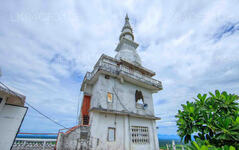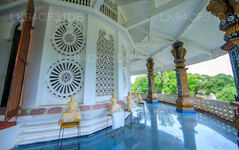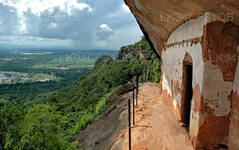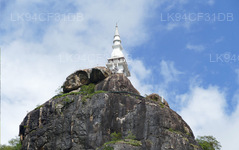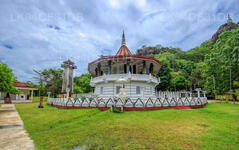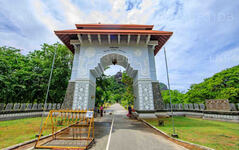
Polonnaruwa City
Polonnaruwa, a UNESCO World Heritage Site in Sri Lanka, was the country's medieval capital (11th-13th century). Renowned for its well-preserved ruins, including the iconic Gal Vihara statues, it showcases impressive architecture, reflecting the grandeur of the ancient Sinhalese civilization.
Dimbulagala Raja Maha Vihara
About 12 miles to the east of the ancient kingdom Polonnaruwa on the east side of the Mahaweli is situated at the beautiful hilly range – Dimbulagala. In our ancient Pali texts this range is referred to as Udumbara – giri. ‘Udumbara’ is a name for wood apples, and ‘giri’ means hills/mountain. Dimbulagala was also known as ‘Dola Pabbatha’.
This area was once known as a kingdom of the Vakshas, then the kingdom of a prince clever in war, then a sacred area, and a Maha Viharaya – an abode of so many sacred beings. With the fall of the Polonnaruwa Kingdom, this was covered by thick forests devoid of its settlers. But it’s up again as an acclaimed abode of many of our monks and trainee monks, who’d be our future preachers of the Buddha’s doctrine – or His Buddha’s disciples.
Going back many centuries it is said that Prince Pandukabahaya, son of Unmadachitra and Deegagamini, lived in the stone cave here with Swarnapali and was accorded much hospitality by the two demon Senadhipathies Chitra Raja and Kala Vela, in human form. Then after some time, in the same stone cave of Dimbulagala, Princess Swarnapali gave birth to a son. He was named Mutasiva, after her father’s name. It’s also mentioned that another Prince was born and named Ganatissa.
Prince Pandukabhaya before he ascended the throne and made Anuradhapura his abode had lived here for many years. After him Mutasiva, his son by Swarnapali became king. It is said that Arahat Mahinda arrived in the Island during his reign in BC 247. Mutasiva was followed by his son the famous King Devanampiyatissa. From all this it becomes clear how important Dimbulagala is to us in tracing the lives of our ancient kings and their survival even under difficult circumstances.
King Dewanampiyatissa, the first properly acclaimed king of Anuradhapura our first kingdom was responsible for the erection of many Viharas. One of the first such Viharas was Dimbulagala. It is also historically important in that from Arahat Mahinda’s time up to the tenure of the last Arahat, Maliyadeva’s time many great Arahats dwelt in Dimbulagala. This is mentioned in the great literary work ‘Saddharmalankaraya. Then there followed unstable and disturbed political periods, with threat to general adminstration and security as well.
Thus we see history repeating itself beginning from the first century into the 20th century. The ascendancy of Vijayabahu I in the 2nd century 1057 BC, saw the revival and reconstruction of Buddhist palaces of worship, when the king himself went through his Coronation/Crowning with the blessings of the Sangha, vowing to safeguard Buddhism. Vijayabahu I restored Dimbulagala Viharaya which had suffered destruction in the hands of the invaders and enemies.
Dimbulagala is also noted for having being made the abode of Kuththagaththatissa, an Arahat who attended the writing down of the scripture at Aluvihare Matale along with five hundred Bhikkus. Hearing this King Valagamba patronised Dimbulagala, by maintaining the caves, erecting flower ponds, fruit gardens and Viharas for the monks and offered to the Bhikkus land, fields and villages.
Queen of Vijayabahu I, Sundara Devi, though an Indian had committed much service by pioneering many industries based in Dimbulagala. Many meditation kuti/caves were built around the Oushada Pokuna or herbs pond. Links had also been established with Anoratha, the King of Burma at the time. Many books on Dhamma were taken to Burma and many more on Tripitakya were demanded from the King of Sri Lanka.
Buddhism suffered a set back again due to lack of Royal patronage immediately after Vijayabahu I. It was at a time when the Sangha itself were disunited that Parakramabahu I ascended the throne and because of services rendered came to be known as Parakramabahu the great. There had been a great deterioration in the Bhikkhu Vinaya as well, the only remedying factor being the existence of Viharadhipathi of Dimbulagala.
The King summoned a Vinaya Sangayana to restore discipline among the Sangha. For this purpose the Viharadhipathi established a Sangha Sabha. In the time of King Parakumbha, a Sangha Sabha was appointed concentrating on the Vinaya/Discipline of the Sangha. Dimbulagala reached an international status as a centre of knowledge with Maha Kassapa as the Chief Priest. It also became famous as a centre for Buddhism and an advisory centre for kings. In Namal Pokuna area lived many monks who had come from Burma etc. who studied here.
The area around Dimbulagala was offered to the Viharya by Parakramabahu I and Matara Kithalagama Most Rev. Siri Seelalankara who rebuilt Dimbulagala which had suffered enemy attacks and turned into a deserted wilderness.
Until his death a few years ago, the Sangha Nayaka treasured Dimbulagala and was a protector of the Viharaya.
The late Maha Nayaka is also remembered for establishing village settlements in the area through granting land, housing facilities and guidance in the last two decades. He encouraged and helped the settlements in Welioya, Janakapura, Welikanda and Kadawatha, Maduwa, but his plans of settlements in Kantale and Vavuniya suffered disappointment. In some of his national ventures he was patronised by all heads of state and the late Gamini Dissanayake had provided him strength, especially in the settlements in Mahaweli Development area.
Dimbulagala which had once been a great centre of learning – it had had religious connections with Burma and Thailand. It had conducted religious teachings in eighteen languages. It had given advice and guided the great kings like King Viajayabahu I and Parakramabahu I. The Royal Queens like Sundara Devi had patronised the erection of Dimbulagala.
Reat clergy residing in Dimbulagala.There’s the belief that a museum in Thailand has in its possession a book engraved in gold on the the Tripitakaya, written by a Thai Prince, that there is a connection between the cessation of hostilities in Thailand throu
About Polonnaruwa District
Polonnaruwa is the 2nd largest city in north central province in Sri Lanka. The ancient city of Polonnaruwa has been declared a World Heritage site by UNESCO Polonnaruwa has a great history of conquest and struggle behind it and rightfully forms the third element in the Cultural Triangle. Located about 140 kms north east from Kandy,Polonnaruwa offers hours of endless pleasure for history and culture lovers, as there are numerous sights of significance.
Much of the physical ruins standing today are credited to King Parakrama Bahu I who spent many royal resources on town planning, including parks, edifices, irrigation systems and so on. The period of his rule is considered a golden age where the kingdom thrived and prospered under a visionary ruler. The Parakrama Samudra is a mammoth tank and named after its patron. The popular kings Royal Palace, the Audience Hall encircled by beautifully carved stone elephants and the Bathing Pool reflect the superior engineering capabilities of the time.
About North Central Province
North Central Province which is the largest province in the country covered 16% of total country's land area. North Central Province consist two districts called Polonnaruwa and Anuradhapure. Anuradhapura is the largest district in Sri Lanka. Its area is 7,128 km².
North Central Province has numerous potentials for Investors to start their Businesses, especially Agriculture, agro based industries and Livestock sectors. More than 65% of North Central Province's people depend on basic Agriculture and agro base industries. NCP also called "Wew Bendi Rajje" because there are more than 3,000 medium and large scale tanks situated in the province. Sri maha bodiya, Ruwanweli seya, Thuparama dageba, Abayagiri Monastry, Polonnaruwa Rankot wehera, Lankathilake are scared

